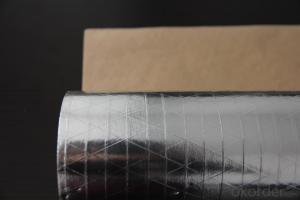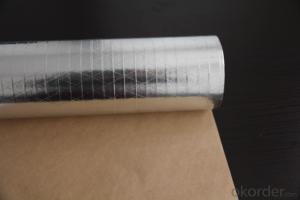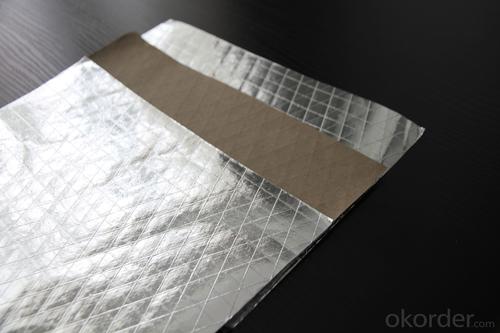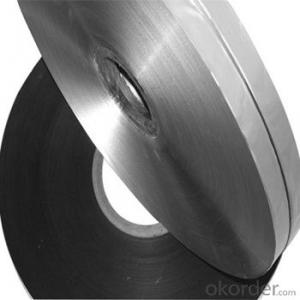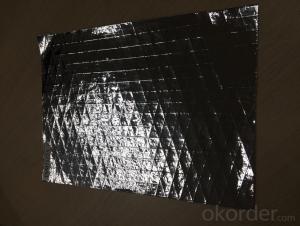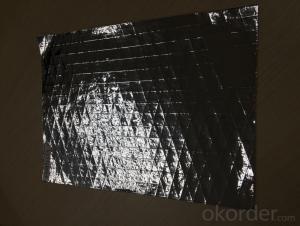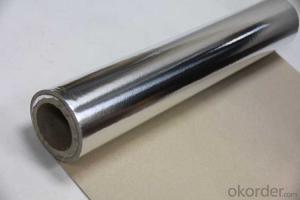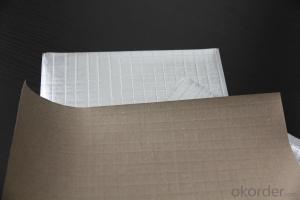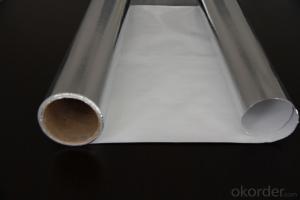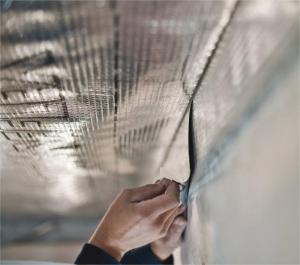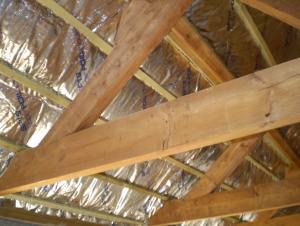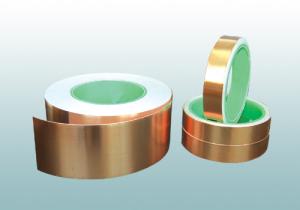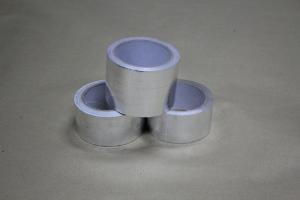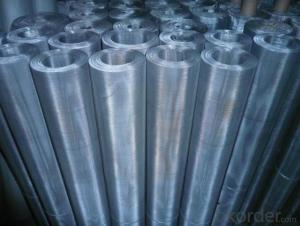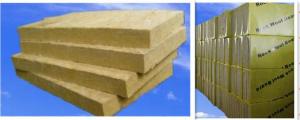Aluminum Foil Facing, Single Side Paper Foil for Glasswool
- Loading Port:
- China Main Port
- Payment Terms:
- TT or LC
- Min Order Qty:
- 5000 m²
- Supply Capability:
- 800000 m²/month
OKorder Service Pledge
OKorder Financial Service
You Might Also Like
Introduction of Aluminum Foil Facing
Aluminum Foil Facing is a kind of film, which is made of by Aluminum foil: 7 microns /Two-way fiberglass scrim: 12.5х12.5mm/Polyethylene/ Kraft paper: 60gsm (natural )
Application of Aluminum Foil Facing
Our aluminum foil facing are mainly used as facing for glass wool insulation, rockwool, mineral wool etc. Also aluminum foil facing is used under roof decking, under attic rafters, over existing attic thermal insulation, in floors, walls and crawl spaces, and in industrial and commercial buildings to block radiant heat coming into house through the roof during the summer and retain indoor heat generated during in winter
Advantage of Aluminum Foil Facing
Light weight
• High manufacturing accuracy
• High strength
• Small inertia resistance
• Strong heat dissipation ability
• Good visual effect
• High reflective insulation
• Heat resistant, water proof, stable at high temperature;
• environmentally friendly, no smell and not-toxic;
• Smooth and clear surface;
Packing of Aluminum Foil Facing
1. Waterproof paper then PVC shrinking Film
2. Kraft paper only
3. Woven cloth
4. Kraft paper or Water Proof Film then Metal/wooden pallet
5. (Also as your request. )
Pictures of Aluminum Foil Facing
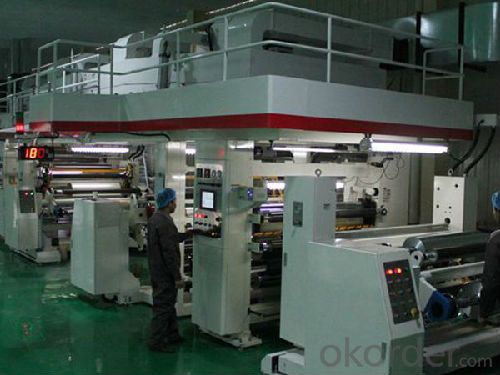
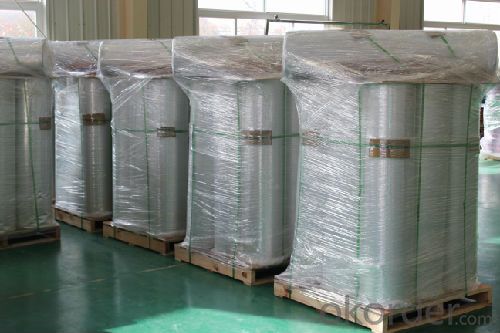

Specification of Aluminum Foil Facing
Aluminum foil: 7 microns
Tri-way fiberglass scrim: M.D: 8/100mm; X.D: 12/100mm
Adhesive: Polyethylene
Kraft paper: 80gsm(Natural)
TYPICAL PHYSICAL PROPERTIES:
PROPERTIES | UNIT | VALUE | TEST METHOD |
Basic weight | gsm | 120 | ASTM D646 |
Tensile strength: M. D. X. D. | N/25mm | 150 60 | ASTM D828 |
Burst strength | N | 35 | ASTM D774 |
Reflectivity of foil surface | % | 95 | ---------- |
Temp. Resistance | -29°C 66°C | No Delamination No Delamination | ASTM C1263 |
Water vapor permeance | ng/N.s | 1.15 | ASTM E-96 |
Remarks:
1. The data above are typical results and subject to change without notice.
2. Tolerance: Weight and Thickness: ±10%; Width: ±3mm;
Length: Cut Roll & Log Roll ±0.3m, Jumbo Roll ±0.5%.
3. The products should be stored at room temperature and kept from wet and heat source.
4. It is essential, as with all pressure-sensitive tapes, that the surface to which the tape is applied must be clean, dry, and free of grease and oil.
5. The user should take test and do trial-application on the above products before coming into application so as to witness and ensure suitability for user’s special purpose and technique.
FAQ
We have organized several common questions for our clients,may help you sincerely:
1. How about your company?
A world class manufacturer & supplier of Aluminum Foil Facing and is one of the large-scale professional investment Aluminum Foil Facing bases in China. Annually more than 1000 containers of Aluminum Foil Facing are exported to markets in Europe, America and Japan.
2. What is the storage condition?
The Aluminum Foil Facing should be stored at room temperature and kept from wet and heat source.
3. How to guarantee the quality of the products?
We have established the international advanced quality management system,every link from raw material to final product we have strict quality test;We resolutely put an end to unqualified products flowing into the market. At the same time, we will provide necessary follow-up service assurance.
4. How long can we receive the product after purchase?
In the purchase of product within four working days, we will arrange the factory delivery as soon as possible. The specific time of receiving is related to the state and position of customers. Commonly 7 to 10 working days can be served.
- Q: Describe the most effective method for folding aluminum foil edges to seal food packaging.
- <p>The best way to fold aluminum foil facing for food packaging involves a few simple steps. Start by placing the food in the center of the foil. Bring two opposite edges of the foil together over the food, ensuring they overlap slightly. Fold one edge over the other, creating a seam. Press down firmly to seal. Repeat this process with the remaining two edges, ensuring all edges are sealed tightly. For added security, you can fold the edges inward to create a double seam. This method prevents leakage and keeps the food fresh and protected during cooking or storage.</p>
- Q: Is it safe and effective to use aluminum foil facing material for wrapping food when preparing for freezing?
- <p>Yes, you can use aluminum foil facing for wrapping food for freezing. Aluminum foil is a good conductor of heat and provides a barrier that helps prevent freezer burn. It is also non-toxic and does not impart any taste to the food. Ensure the foil is tightly wrapped around the food to maintain its freshness and protect it from air exposure. However, it's important to note that aluminum foil is not microwave-safe, so if you plan to reheat the food, you should transfer it to a microwave-safe container before heating.</p>
- Q: What are the precautions to be aware of when using aluminum foil in the kitchen?
- <p>When using aluminum foil in the kitchen, it's important to avoid direct contact with acidic or alkaline foods as it may react and contaminate the food. Do not use it in broilers or ovens above 450掳F (232掳C), as it can melt and release harmful fumes. Avoid wrapping food in aluminum foil for extended periods, especially at high temperatures, as it may lead to the foil breaking down and leaching aluminum into the food. Always check for any tears or punctures in the foil to prevent food from coming into contact with the cooking surface directly.</p>
- Q: Is it safe to use recycled aluminum foil for cooking or baking purposes?
- <p>Recycled aluminum foil facing is not recommended for cooking or baking. While aluminum foil itself is safe for cooking and can be used to cover dishes or line baking sheets, recycled foil may have impurities or contaminants from previous uses. It may also be thinner and less durable, leading to potential tearing or puncturing, which can result in food contamination. For safety and food quality, it's best to use new, high-quality aluminum foil for cooking and baking.</p>
- Q: This question asks for methods to prevent metal flakes from aluminum foil from getting into the eyes or mouth while using it.
- <p>To avoid getting metal flakes from aluminum foil into your eyes or mouth, handle the foil carefully with clean, dry hands. Avoid using foil that is crumpled or damaged, as it can release more flakes. When cutting foil, use a sharp knife to minimize the creation of small particles. Keep foil away from your face and eyes while handling, and consider wearing safety glasses if you are concerned about eye safety. Wash your hands thoroughly after handling aluminum foil to remove any residual flakes before touching your face or eating.</p>
- Q: Explain the various applications of aluminum foil facing in different contexts.
- <p>Aluminum foil facing can be used in various ways depending on the application. In construction, it serves as a vapor barrier to prevent moisture from affecting the insulation. In packaging, it's used for food preservation, providing a barrier against air and light, which helps to keep food fresh. In the automotive industry, it's used for heat reflection and insulation in car engines. It's also used in the manufacturing of reflective materials and in art for creating unique textures and effects. Additionally, aluminum foil facing is utilized in the aerospace industry for heat shielding and in the medical field for sterilization purposes. Each application leverages the properties of aluminum foil, such as its light weight, durability, and heat resistance.</p>
- Q: Explain the distinction between aluminum foil insulation with and without a vapor barrier.
- <p>Aluminum foil insulation with a vapor barrier is designed to prevent moisture from passing through, which is crucial in humid environments to prevent condensation and mold growth. The vapor barrier is a layer that acts as a moisture control, enhancing the insulation's effectiveness. On the other hand, aluminum foil without a vapor barrier does not have this moisture-resistant layer, making it less effective in controlling moisture and potentially leading to condensation issues. The presence of a vapor barrier can also impact the thermal performance and energy efficiency of the insulation.</p>
- Q: What are some effective techniques or suggestions for utilizing aluminum foil in various applications?
- <p>Using aluminum foil effectively involves a few tricks: 1) For cooking, use a double layer to prevent food from sticking and to distribute heat evenly. 2) When grilling, crumple the foil to create a heat-reflective dome for indirect cooking. 3) Line baking sheets with foil to simplify cleanup. 4) Use foil to create makeshift containers for baking, such as foil packets for vegetables or fish. 5) For storage, wrap food tightly to preserve freshness. 6) When roasting meats, tent with foil to lock in moisture. 7) Use foil to create a barrier between food and the grill grates to prevent flare-ups. Remember, avoid using foil with acidic foods as it can react and release aluminum into the food.</p>
- Q: Explain the differences between aluminum foil facing and other types of food wrap.
- <p>Aluminum foil facing is a type of food wrap that is made from thin sheets of aluminum, which provides excellent barrier properties against air, moisture, and light. It is often used for cooking, baking, and preserving food. Unlike plastic wraps, it does not stick to food and can withstand high temperatures without melting. Other types of food wraps, such as plastic or cling wraps, are made from polymers and are not heat resistant. They are typically used for short-term food storage and are not suitable for cooking. Paper-based wraps, like parchment or wax paper, are used for baking and providing a non-stick surface but do not offer the same barrier properties as aluminum foil.</p>
- Q: What safety measures should be considered when working with aluminum foil facing materials?
- <p>When using aluminum foil facing, it's important to handle it carefully to avoid punctures or tears. Always use gloves to protect your hands from sharp edges. Ensure proper ventilation to prevent inhalation of aluminum particles. Avoid using aluminum foil facing near open flames or high heat sources as it can melt or catch fire. Store aluminum foil facing in a cool, dry place, away from direct sunlight to prevent degradation. Always follow the manufacturer's guidelines for safe use and disposal.</p>
Send your message to us
Aluminum Foil Facing, Single Side Paper Foil for Glasswool
- Loading Port:
- China Main Port
- Payment Terms:
- TT or LC
- Min Order Qty:
- 5000 m²
- Supply Capability:
- 800000 m²/month
OKorder Service Pledge
OKorder Financial Service
Similar products
Hot products
Hot Searches
Related keywords

